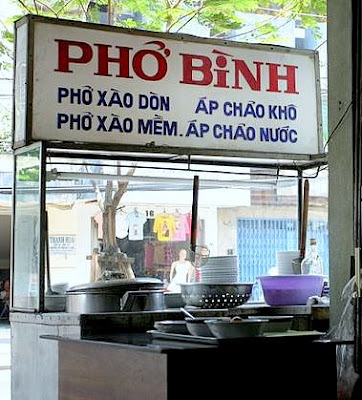There are way too many things to see in Saigon, and heaven knows if I'll ever get to see them all. This particular pho shop was in my guidebook, and the two or three sentences that followed the name had me completely smitten. This was just a place we had to see. Chuck as usual, was all atwitter about what kind of place is this, and who goes there, and what not.
We took a cab there, since I had no clue where it was, and since it wasn't within District One, I didn't want to waste time getting there. And so this is what we saw when we arrived at destination.
Motorbikes are always parked either on the sidewalk, or inside the shops. Actually, at the Indochine Hotel, they had 3 of them parked in the reception area. It was not very crowded inside, but the entire area around the restaurant was bustling. Chuck was definitely antsy, but I got a bit closer to check the noodle stand outside the premises. After our second trip to Vietnam, it was a foregone conclusion that you cannot have a bad bowl of pho, no matter where you eat it.
 Now doesn't that look yummy? If you don't know it, pho noodles are rice based, therefore much lighter than wheat based noodles and very easily digested. Vietnamese have pho any time of the day, including breakfast. We did go inside, and I wanted to insure that we had found the right place.
Now doesn't that look yummy? If you don't know it, pho noodles are rice based, therefore much lighter than wheat based noodles and very easily digested. Vietnamese have pho any time of the day, including breakfast. We did go inside, and I wanted to insure that we had found the right place.The man who owned this pho shop played host to both American soldiers and Viet Cong during the American War, and his son has amassed quite a collection of pictures and citations in the name of his father. As we were the only Westerners in the shop, a tall man came toward us and for lack of understanding each other, I showed him the guide book, and he immediately understood what I meant. He showed us to a table, and returned with many albums.
There was obviously tremendous pride in what Ngo Toai had done during the war, and his pho shop rose to prominence, but he absolutely refused to give his tables and chairs and any of his war memorabilia to the War Museum. The restaurant floors beg for a good scrubbing, but it is with reverence that one enters the premises.
these tables and chairs are witnesses to the men who fought
during the war and came here for a bowl of pho
Here we are below, completely captivated with reading and looking and pictures, while enjoying the best bowl of pho ever, and I squeezed as much lime as I could find into it.
If you look at the picture on the right, above are two framed certificates. I was able to capture on camera a close up of the larger one, and the other one has a photo of Ngo Toai with American soldiers eating in his soup kitchen. Many wrote him letters after they went back home. The newspaper clippings are stained and in some disrepair, but they are a greater source of pride as they are written in English.
There are certificates on the wall bearing the red communist star; medals are photographed but now shown. When the war ended, Ngo Toai returned to his beloved noodle shop and continued to serve his magical brew. It seems the menu has not changed much since that day. Heartwarming are the photos of U.S. veterans who returned to this shop, and have their arms around the old man.
how priceless is this?
The Reuters article above provocatively begins this way: “ In the early years of the Viet Nam war, Ngo Toai lived a double life: seller of noodles to U.S. personnel and surreptitious revolutionary”. And of course, you read on. Apparently, a few days following the Tet offensive, a South Vietnamese tried to kill Ngo Toai, but somehow he escaped death only to find life imprisonment and torture instead.
the circled area of the page talks about the liberation of Toai
As you can read, Toai was captured and tortured; our guide to the Mekong Delta would later inform us that many people were sent for "re-education". I leave it to your imagination to figure this out.
 The shop served as a front for the undercover command post from which the plan for the Tet offensive was devised. After the war, foreign tourists would pay up to $13/night to put their heads on a pillow in the very area that served as a gathering place for the Viet Cong. I regret that we didn't decide to do likewise, but we had quite an itinerary on this first trip, which had been set back somewhat due to an unexpected food poisoning episode.
The shop served as a front for the undercover command post from which the plan for the Tet offensive was devised. After the war, foreign tourists would pay up to $13/night to put their heads on a pillow in the very area that served as a gathering place for the Viet Cong. I regret that we didn't decide to do likewise, but we had quite an itinerary on this first trip, which had been set back somewhat due to an unexpected food poisoning episode.All things aside, this café does serve a wicked pho. They also have "bia", which is the Vietnamese word for "beer" , which actually came from the French word "bière".
the view from inside the restaurant
you can see the parked motorbikes inside








0 comments:
Post a Comment